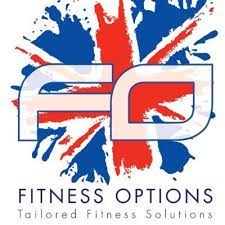Starting a new exercise routine in your 50s may feel slightly intimidating; however, there is no reason for you to worry. Exercising in your 50s can be as straightforward or as challenging as you like, and embarking on a fitness journey is an excellent move for your health and fitness.
Ready to transform your life? Whether you're looking for a new pair of running shoes or some shiny home gym equipment, you can find everything you need to fuel your fitness journey with our partner brands.
What should an over 50s exercise routine look like?
In many ways, a typical exercise routine for an over 50 should look no different to an exercise routine for someone in their 20s. A full-body resistance workout that lasts 40-60 minutes (with lots of rests) will suit any age group.
Once you pass 50, there are, of course, some things that you may need to avoid. For example, following a bodybuilding-style routine where you train a different muscle group each day would not work well. But that style of exercise routine only works well for bodybuilders in any case!
After 50, you may also feel that high-intensity exercise routines no longer appeal. CrossFit, HIIT classes, or plyometrics (lots of jumping) are by no means impossible. Still, the risk/benefit ratio is well off.
What is the best exercise for 50-year-olds?
Many exercises are beneficial for 50-year-olds. The bodyweight squat is an excellent lower body exercise that can help to:
- Improve mobility.
- Increase strength.
- Increase flexibility.
- Prevent lower back pain.
Then again, the push up is a superb upper body exercise that people too often neglect. There is an assumption that performing push-ups is something that most people can't or perhaps shouldn't do. But push-ups are a very low-risk exercise, and most people can manage to complete at least a couple after a few weeks of practice.
Push-ups may not be as practical as squats, but they are certainly more impressive and can give your self-confidence a boost! Push-ups are an exercise that anyone in their 50s, 60s, or even 70s and 80s should attempt to master.
Another great exercise is the plank. The plank is a core exercise that works your lower back, your glutes, abdominal muscles, and many other smaller muscles in your body. You can perform it in a traditional push-up position or with your forearms resting on the floor. Start with a five-second plank, and then progress to 30 seconds.
Once you can manage a 30-second plank fairly easily, perform several sets of this. Many people believe that performing planks for longer than 30 seconds will yield better results, but this isn't the case.
Perhaps the best exercise for 50-year-olds is walking or hiking. It's free, involves a lot of fresh air, and is excellent for mental health. In a (hopefully) post-Covid UK, it is the ultimate socially distanced exercise, too!
We spoke to Personal Trainer and Nutritionist Yvonne Heiden, who told Health Times: "When you’re new to exercise, bodyweight movements are a great place to start! Some of the benefits of resistance training may include a lower risk of falling and reduced impact when falls do occur, a positive effect on self-sufficiency in older age, as well as increased bone-density and better posture."
How many times a week should a 50-year-old workout?
How often you work out each week depends on several variables:
- How fit are you?
- How intense are your workouts?
- How much time do you have available?
- What are your goals?
Let’s look at each of these questions in turn.
How fit are you?
If you are just starting an exercise routine and haven't done anything consistently for a few years, you should train sparsely. Walking or hiking is a different matter; you can do those daily. But if you are thinking of going to the gym or training at home, you should start with just 2-3 sessions per week, with at least 24 hours rest in between sessions.
If you consider yourself reasonably fit but want to push yourself a little further, you could probably train 4-5 times per week.
How intense are your workouts?
How challenging your workouts are will also affect how often you train. A ten-minute bodyweight workout is low in intensity, so you could probably train every day without any issue.
If, however, you are planning on an hour of weight training, then you may need to restrict your exercise to just two days per week. Perhaps do some walking or hiking on your days off; this is known as active rest.
How much time do you have available to work out?
Are you currently retired? If so, then time may not be an issue. You could probably find the time to train every single day. But what if you are working? Or if you volunteer for several hours each day? In that case, you may struggle to train as often as you would like.
If this is the case, you have two options. Either find ways to make time or be more realistic with your exercise routine.
What do you want to achieve?
Are you looking to lose quite a lot of weight? Then you may need to train several times per week. Are you just looking to get a bit more exercise? Then 2-3 times a week might be more than enough.
Check out our previous guide to losing weight while eating what you want.
How many times a week?
Once you have worked out how fit you are, how intensely you want to train, and how much time you have to train, you can decide how many times per week you should train.
Most people will struggle to hit five times per week, but two times per week may not be enough.
I recommend a combination of proper training (gym workout, home exercise routine) twice a week and going for a relatively long walk on the other days. Most people can walk around three miles in an hour, and doing that on your "rest" days will make a massive difference. That should be a great starting point, and you can, of course, increase the number of gym or home workouts you do as your fitness improves.
How do I start working out in my 50s?
If you have a gym near your house, signing up is a great way to start working out. Most gyms offer a free induction, where a fitness instructor will show you around the gym and give you a simple program to follow.
This is very basic and may not be specific to your needs. Still, it can be an excellent introduction to the gym and should increase your confidence. You can also hire a personal trainer (if your budget will allow) to give you a more specific training program and take you through it.
Another way to start is to train at home. YouTube has many fantastic workout programs designed specifically for over 50s. Check out our top 5 YouTube channels for active over 50s article to learn more.
Whether you decide to start at home or in the gym, a full-body workout with light weights and high reps is a good idea. Two to three workouts per week should be effective and will give you enough time to recover.
Should I train in a gym?
This is up to you and depends on whether you want to pay for a gym membership and how comfortable you feel going to the gym. There are many benefits to training in a gym. They have lots of equipment, which means that your workouts can be more adventurous and enjoyable.
They also have the social element that training at home doesn’t. Some people struggle to find the motivation to train at home, but the routine of travelling to the gym, getting changed, and then walking through the door can really help.
On the other hand, some people find it easy to train at home but find the extra steps required to get into a gym to be too much effort. If this sounds familiar to you, then training at home is ideal.
One of the best reasons to train in a gym is that other people can assess your technique or help you if you are struggling. If you have never exercised before, it can be tough to determine if you perform each exercise correctly. Poorly executed exercises can increase your risk of injury.
Should I train at home?
If you don't like the idea of signing up at the local gym, you have several other options for exercising. Why not download a fitness challenge to your phone and follow that? Our article on the five best fitness challenges helps find creative ways to motivate you to move more without the need for the gym.
Alternatively, you can sign up for a subscription service. Peloton is famous for their exercise bike based workout programs, which you can sign up for at a fraction of the cost of most fitness classes. Or there are classes such as Les Mills on Demand.
Check out our article on the top 5 subscription services to find one that suits your needs.
Creating your own workouts from home is also perfectly possible. All you need is some space to do so, and perhaps some equipment, like a pair of dumbbells, an exercise mat, and a kettlebell. It’s easy enough to find workouts online that you can follow. Other than purchasing the equipment, this option is 100% free.
What about diet?
There is little point in pursuing an exercise routine if you aren't going to make some minor changes to your diet. We all know eating less chocolate and keeping our alcohol consumption within health guidelines are sensible. What other practical steps we can take?
Increase protein at breakfast
When you start exercising, your protein requirements will increase slightly. This is because protein is necessary for muscle growth and recovery. Most adults tend not to eat enough protein in any case.
A 2020 study from the University of Sheffield found that more than half of older people don’t consume enough protein to stay healthy. With the recommended amount of 25-30g per meal not being hit by most adults.
It’s easy to hit your protein targets during your evening meal, but lunch and breakfast are another matter. Why not get your day off to the perfect start by adding a protein source to your breakfast. Here are five options:
- Eggs
- Protein shake
- Greek Yoghurt
- Smoked salmon
- Canadian bacon (try to keep your processed meat to a minimum)
Add fruit and vegetables to breakfast and lunch
The recommended intake for fruit and vegetables is often thought to be five a day, and most adults struggle to hit that. The actual target is seven, and some recommendations even say ten!
Again, your evening meal (or main meal if you have it at lunchtime) is usually pretty easy to add vegetables to. But breakfast and lunch are more challenging.
Combine protein sources from the previous section with fruit or vegetables to get the best of both. Eggs go well with spinach, mushrooms, peppers, kale, onions, and chillies.
In contrast, a protein shake is better with fruit, as is Greek yoghurt. Or you can make a smoothie that contains fruit, veg, protein powder, and some yoghurt for a high protein breakfast that contains 2-3 of your seven a day target.
Drink more water
If you plan on exercising more, you must ensure you stay hydrated, particularly during the hotter months of the year. Grab yourself a 1.5-litre bottle and try and finish at least one or possibly even two each day.
What to do now?
Decide what it is you want to achieve and ask yourself what your current fitness level is. Think about how much free time you have and if you wish to train at home, in the gym, or follow a fitness challenge outdoors.
Then, find yourself a new workout - ask the gym staff or go online - and start slowly, once or twice per week. Look at ways to improve your diet, with more protein and more fruit and vegetables at breakfast. And remember to drink more water!
This will ensure that your new exercise routine is a success, and you will soon see excellent results.
Good luck!









